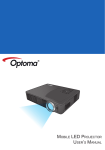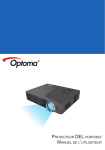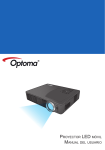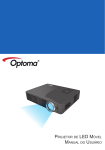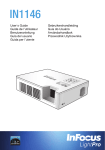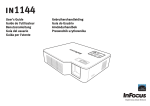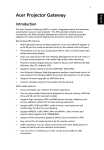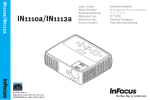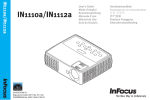Download Optoma TL50W data projector
Transcript
Mobile LED Projector User’s Manual Important Safety Instruction CLASS 1 LED PRODUCT Eye Safety Warnings Avoid staring/facing directly into the projector beam at all times. Keep your back to the beam as much as possible. A stick or laser pointer is recommended to avoid the need for the user to enter the beam. When projector is used in a classroom, adequately supervise students when they are asked to point out something on the screen. In order to minimize power, use room blinds to reduce ambient light levels. A.2.9.31 Gloss of housing of peripheral (15th / 22 meeting AG1 EK1): devices The requirements for the gloss of housing apply to peripheral devices used at the visual display workplace according to BildscharbV. Peripheral devices intended for use outside the visual display workplace can receive a GS-Mark if the scope is indicated in the User’s Manual as well as the certificate. That means the following wording is possible in situations where the use within the field of view is not intended and where sufficient hints are given in the User’s Manual for the avoidance of such situations to ensure that display work is not affected. Wording in the certificate: “This device is not intended for use in the direct field of view at visual display workplaces. To avoid incommoding reflexions at visual display workplaces this device must not be placed in the direct field of view.” Regulation & safety notices This appendix lists the general notices of your Projector. FCC notice This device has been tested and found to comply with the limits for a Class B digital device pursuant to Part 15 of the FCC rules. These limits are designed to provide reasonable protection against harmful interference in a residential installation. This device generates, uses, and can radiate radio frequency energy and, if not installed and used in accordance with the instructions, may cause harmful interference to radio communications. However, there is no guarantee that interference will not occur in a particular installation. If this device does cause harmful interference to radio or television reception, which can be determined by turning the device off and on, the user is encouraged to try to correct the interference by one or more of the following measures: • Reorient or relocate the receiving antenna. • Increase the separation between the device and receiver. • Connect the device into an outlet on a circuit different from that to which the receiver is connected. • Consult the dealer or an experienced radio/television technician for help. 2 Notice: Shielded cables All connections to other computing devices must be made using shielded cables to maintain compliance with FCC regulations. Caution Changes or modifications not expressly approved by the manufacturer could void the user’s authority, which is granted by the Federal Communications Commission, to operate this device. Operation conditions This device complies with Part 15 of the FCC Rules. Operation is subject to the following two conditions: 1. this device may not cause harmful interference, and 2. this device must accept any interference received, including interference that may cause undesired operation. Notice: Canadian users This Class B digital apparatus complies with Canadian ICES-003. Remarque à l’intention des utilisateurs canadiens Cet appareil numerique de la classe B est conforme a la norme NMB-003 du Canada. Declaration of Conformity for EU countries • EMC Directive 2004/108/EC (including amendments) • Low Voltage Directive 2006/95/EC • R & TTE Directive 1999/5/EC (if product has RF function) 1.Do not block any ventilation openings. To ensure reliable operation of the projector and to protect from over heating, it is recommended to install the projector in a location that does not block ventilation. As an example, do not place the projector on a crowded coffee table, sofa, bed, etc. Do not put the projector in an enclosure such as a book case or a cabinet that restricts air flow. 2.Do not use the projector near water or moisture. To reduce the risk of fire and/ or electric shock, do not expose the projector to rain or moisture. 3.Do not install near heat sources such as radiators, heaters, stoves or any other apparatus such as amplifiers that emits heat. 4.Do not use the projector in direct sunlight. 5.Do not use near any appliance generating a strong magnetic field. 6.Do not use the projector in areas susceptible to excessive dust and dirt. 7.Turn off the product before cleaning. 8.Disconnect the power cord if the product is not being used for a long period of time. 9. Ensure that the ambient room temperature is within 5- 35°C. 10.Relative Humidity is 5 - 35°C, 80% (Max.), non-condensing. 11.Do not drop, throw or try to bend your product. 12.May explode if disposed of in fire. 13.Clean only with dry cloth. 14.Only use attachments/accessories specified by the manufacturer. 15.Do not use the unit if it has been physically damaged or abused. Physical damage/abuse would be (but not limited to): ▀■Unit has been dropped. ▀■Charger or plug has been damaged. ▀■Liquid has been spilled on to the projector. ▀■Projector has been exposed to rain or moisture. ▀■Something has fallen in the projector or something is loose inside. Do not attempt to service the unit yourself. Opening or removing covers may expose you to dangerous voltages or other hazards. Please contact your local reseller or service center before you send the unit for repair. 16.Do not let objects or liquids enter the projector. They may touch dangerous voltage points and short out parts that could result in fire or electric shock. 17.See projector enclosure for safety related markings. 18.The unit should only be repaired by appropriate service personnel. 19.Do not touch the projector for a long time while the projector is used. Disposal of old Electrical & Electronic Equipment (Applicable throughout the European Union and other European countries with separate collection programs) This symbol found on your product or on its packaging, indicates that this product should not be treated as household waste when you wish to dispose of it. Instead, it should be handed over to an applicable collection point for the recycling of electrical and electronic equipment. By ensuring this product is disposed of correctly, you will help prevent potential negative consequences to the environment and human health, which could otherwise be caused by inappropriate disposal of this product. The recycling of materials will help to conserve natural resources. This symbol is only valid in the European Union. If you wish to discard this product, please contact your local authorities or dealer and ask for the correct method of disposal. Product Overview 9 10 11 22 23 1 2 3 4 5 6 7 11 8 12 13 14 15 16 17 SD Card VGA 18 19 20 S-Video Video Audio/AV in 21 24 mini USB Remote Control 1.Speaker 2. Auto Source Button ( 3.Up Button ( ) 4. Power Button ( ) ) 5.OK Button ( 6.Left Button ( ) 7.Down Button ( ) 8.Right Button ( ) 9. Focus Dial 10.Lens 11.IR Receiver 12.Kensington Lock 1.Zoom Button 2. Power Button 3.Up Button 4. Menu Button 5.OK Button 6.Left Button 7.Aspect Ratio Button 8.Down Button 9. Volume Up Button 10.Volume Down Button 11.Hide Button 12.LED Mode Button 13.Right Button 14.Media Button 15.VGA Button 16.HDMI Button 17.Video Button 18.S-Video Button 13.DC Input 14.SD Card Slot 15.USB Type A Port 16.HDMI Connector 17.VGA Connector 18.S-Video Input Connector 19.Video In 20.Audio / AV In 21. Mini USB Port 22.Elevator Foot 23.Screw Hole for Tripod 24.Ceiling Mount Holes ) <Note> Items 3 and 5~8 are also function buttons. Functions vary depending on the current mode. Package Overview 1 2 Power Zoom Hide 3 5 6 MENU MEDIA HDMI VGA S-Video Video 2 7 8 Standard Accessory 1. Power cord 2. VGA cable 3. Mini-USB to USB Type-A cable 4. Remote control 5. Carrying case Power Zoom Hide 2 11 3 4 12 MENU 5 13 6 7 MEDIA 8 HDMI VGA S-Video Video 14 15 9 16 10 17 18 Power On / Off 1 4 1 Optional Accessory 6. Video cable 7. VGA to Component cable 8. HDMI cable 1. Connect the power cord to the AC IN input jack on the rear of the projector. () 2. Insert the plug at the other end of the power cord into a power outlet. () The LED lights red in standby mode. 3. Press the Power button ( ) to turn the projector on or off. () The LED turns blue when the projector is turned on. 3 <Note> •• The standard accessories may vary in each region due to different applications. •• The inclusive power cord varies per region. 3 Adjust Projected Image Height Adjust the Projected Image Projection Distance (A) The projector is equipped with an elevator foot for adjusting the projected image height. Screen Size - Width (B) Screen Size - Height (C) Screen Diagonal (D) Meter inch (mm) (inch) (mm) (inch) (mm) (inch) 0.5 20.18 366.2 14.4 228.9 9 432 17 0.9 35.62 646.2 25.4 403.9 15.9 762 30 1.5 59.36 1077 42.4 673.1 26.5 1270 50 1.8 71.23 1292.3 50.9 807.7 31.8 1524 60 2.4 94.98 1723.1 67.8 1077 42.4 2032 80 3.0 118.72 2153.9 84.8 1346.2 53 2540 100 3.6 142.46 2584.7 101.8 1615.4 63.6 3048 120 4.5 178.08 3230.9 127.2 2019.3 79.5 3810 150 5.4 213.7 3877 152.6 2423.2 95.4 4572 180 To adjust the height: Turn the elevator foot to adjust the projected image position to the desired height. <Note> After a few seconds, if there is no changes, the projector will automatically adjust the image display via Auto Keystone function. 1 Adjust the focus () until the image is clear. Connect input source - VGA / S-Video /HDMI Connect input source - Composite AV 1. Connect the VGA / S-Video / HDMI device using an appropriate cable. (~) 1 1. Connect the AV input source. (~) 2. After powering on the projector, 2. After powering on the projector, press 2 press 1 to switch input source. or or 1 1 TM 1 or For video and audio input IPad 1 2 to switch input source. <Note> 1. All other brand and product names are trademarks or registered trademarks of their respective companies. 2. The cables connecting the video output devices are not supplied, please contact the device vendor or Optoma. 3. iPod nano/iPod touch/iPhone/iPod classic (version 5 and above) 4. Designed for iPod/iPhone/Mobile phone/ PMP with TV out functions. Using with devices with audio signal voltage > 0.3Vrms is not recommended. 2 2 2 IPhone 4 or HDMi 2 TM Apple Digital AV Adapter 1 Audio input only 2 1 2 TM 4 in Connect Computer for USB Display By default, the projector displays from the internal memory. However if an SD card is inserted, the projector reads from the SD card first. CK 2 Insert SD Card LO 1 You can project your computer display using the projector's mini USB port. 1Connect a laptop or PC using the supplied mini-USB to USB Type-A cable. 2. Turn on the projector. 3. Press / / / to highlight mini-USB > USB Display to enter USB and press display mode. See "USB Display Mode" section in "USB Mode" on page 18. Insert an SD card into the slot with the gold contacts facing down. <Note> •• To remove the SD card, push the card to eject it from the slot. •• Do not remove the SD card while the projector is projecting image from the card. This can cause data loss or damage the card. •• Supports SD card size up to 32GB. •• The SD card is not included in the package. Insert USB Flash Drive Plug a USB flash drive into the USB Type A port at the back of projector. <Note> Support USB flash drive with FAT32 and NTSF format. Connect Computer for Data Transfer 1 2 You can transfer data to the projector internal memory or the SD card. 1.Connect a laptop or PC using the supplied mini-USB to USB Type-A cable. 2. Turn on the projector. 3. Press / / / to highlight mini-USB > Data Transfer and press to enter data transfer mode. 4.Browse for Removable Disk. 5. Copy the files to your computer. See "Data Transfer Mode" section in "USB Mode" on page 18. Mount the Projector Screw hole for tripod Screw a standard tripod into the screw hole on the projector. <Note> The laptop/PC can only detect the input source when the projector is switched on. *Standard Tripod *Ceiling Mount Screw holes for ceiling mount 1.Place the projector upside down on a flat surface. 2.Line up the three mounting holes and use the three ceiling mount screws to secure the mount to the projector. <Note> The tripod and ceiling mount are optional accessories. 5 How to Use the Menu OK Button Up Button Left Button •• Use / / / to highlight the desired option and press selection. •• Buttons functionality varies depending on the current mode. to confirm the <Note> A button guide appears on the lower left corner of most screens. The guide varies depending on the current mode. Press the corresponding button to select the option or operation. Right Button Down Button Home menu Submenu Travel runner.avi summer.avi unfair.avi runner.avi Press / / / to select the menu item that you want to access and press Back icon Highlight this icon and press to enter the menu screen . to return to previous screen. Data source icon Press to switch the memory sources: Video menu Internal memory » SD card » USB flash drive. Internal memory USB flash drive (only supports FAT 32 format) SD card Submenu Items 1/2 Travel Love song.mp3 runner.avi summer.avi unfair.avi Goodbye.mp3 runner.avi Video menu Music menu Photo menu .. travel.doc 128 KB 1,211 KB 143 KB 165 KB 6 mini-USB menu Office Viewer menu Setup menu How to Play Videos - Source: Internal Memory / SD Card / USB Flash Drive Playing Videos from the Internal Memory, SD Card, or USB Flash Drive If an SD card is inserted, the content of the memory card is read first. If you want to read data from the internal memory or USB flash in the appropriate screen to drive, press change the data source. See steps below. 2. Select Data Source The screen, the source icon on the button guide, and the sequence in which screens appear vary depending on the available data source. Travel runner.avi summer.avi unfair.avi runner.avi 1. Enter "Video" Menu 3. Select Video File Select Video Change data source Travel Travel runner.avi runner.avi summer.avi summer.avi unfair.avi unfair.avi runner.avi runner.avi Home menu <Note> The displayed screen may vary depending on the selected data source on the previous step. Change data source Return Home Menu Travel Start playback runner.avi summer.avi unfair.avi runner.avi Travel runner.avi summer.avi unfair.avi runner.avi Change data source 4. Playback File Video Playback mode (see page 8) 7 How to Play Videos - Video Playback Mode <Note> The button guide disappears when the keypad is not used for 3 seconds. To display the button guide, press any key. Highlight this icon and to exit press video playback mode. Media Playback Control Increase volume + Rewind Decrease volume + Fast forward + Pause + Previous video clip + Play + Next video clip Video Settings 1. Select "Setup" 2. Enter "Setup" Menu 3. Enter "Video Setting" Menu 5. Select Option 4. Select Setting Home menu Repeat all Repeat Repeat one Repeat disabled Browser display 8 Browser display small icon Browser display large icon How to Play Music - Source: Internal Memory / SD Card / USB Flash Drive Playing Music from the Internal Memory, SD Card, or USB Flash Drive If an SD card is inserted, the content of the memory card is read first. If you want to read data from the internal memory or USB flash in the appropriate screen to drive, press change the data source. See steps below. 3. Select Data Source The screen, the source icon on the button guide, and the sequence in which screens appear vary depending on the available data source. 2. Enter "Music" Menu Love song.mp3 Goodbye.mp3 1. Select "Music" Change data source Love song.mp3 Goodbye.mp3 Home menu Change data source Return Home Menu Love song.mp3 Goodbye.mp3 Love song.mp3 Goodbye.mp3 Change data source 5. Playback File 4. Select Music File Start playback Love song.mp3 Goodbye.mp3 Music Playback mode (see page 10) <Note> The displayed screen may vary depending on the selected data source on the previous step. 9 How to Play Music - Playback Mode <Note> The button guide disappears when the keypad is not used for 3 seconds. To display the button guide, press any key. Highlight this icon and to exit press music playback mode. Media Playback Control + Increase volume + Play Decrease volume + Previous track Pause + Next track Music Settings 1. Select "Setup" 2. Enter "Setup" Menu 3. Select "Music Setting" 5. Select Setting 4. Enter "Music Setting" Menu Home menu 6. Select Option Repeat all Repeat Repeat one Repeat disabled Shuffle 10 Shuffle on Shuffle off How to View Photos - Source: Internal Memory / SD Card / USB Flash Drive Viewing Photos from the Internal Memory, SD Card, or USB Flash Drive If an SD card is inserted, the content of the memory card is read first. If you want to read data from the internal memory or USB flash in the appropriate screen to drive, press change the data source. See steps below. 3. Select Data Source The screen, the source icon on the button guide, and the sequence in which screens appear vary depending on the available data source. 2. Enter "Photo" Menu 1/2 1. Select "Photo" Change data source 1/2 Home menu Change data source Return Home Menu 1/2 1/2 Change data source 5. Preview File 4. Browse Thumbnails Start playback Slideshow at Full Screen mode (see page 12)) 1/2 <Note> The displayed screen may vary depending on the selected data source on the previous step. 11 How to View Photos - Mode: Slideshow at Full Screen During slideshow, photos are played continuously at a specified interval time while playing music stored in the internal memory as background. <Note> The button guide disappears when the keypad is not used for 3 seconds. To display the button guide, press any key. <Note> •• To change slideshow interval settings and enable/disable background music, see Slideshow Settings below. •• Make sure that background music setting is "On" to enable this feature. •• Save the music files (*.mp3 format) under the "/mnt/disk/bgm" folder in the internal memory via data transfer function. •• Only music files stored in the internal memory "/mnt/disk/bgm" folder can be played as background music. Highlight this icon and to exit press slideshow mode. Media Playback Control Increase volume + Slideshow on Decrease volume + Slideshow off Slideshow Settings 1. Select "Setup" 2. Enter "Setup" Menu 3. Select "Slideshow" 5. Select Setting 4. Enter "Slideshow" Menu Home menu 6. Select Option Timer: 2-second interval Timer Timer: 5-second interval Timer: 10-second interval Music 12 Background music on Background music off How to View Documents - Source: Internal Memory / SD Card / USB Flash Drive Viewing Documents from the Internal Memory, SD Card, or USB Flash Drive If an SD card is inserted, the content of the memory card is read first. If you want to read data from the internal memory or USB flash in the appropriate screen to drive, press change the data source. See steps below. 3. Select Data Source The screen, the source icon on the button guide, and the sequence in which screens appear vary depending on the available data source. 2. Enter "Office Viewer" Menu .. travel.doc 128 KB 1,211 KB 143 KB 165 KB 1. Select "Office Viewer" Change data source .. travel.doc 128 KB 1,211 KB 143 KB 165 KB Change data source Home menu Return Home Menu .. travel.doc 128 KB 1,211 KB 143 KB 165 KB .. travel.doc 128 KB 1,211 KB 143 KB Change data source 165 KB 5. View File 4. Select File Open document .. Report travel.doc 128 KB 1,211 KB 143 KB 165 KB View mode (see page 14) 13 How to View Documents - View Mode <Note> The button guide disappears when the keypad is not used for 3 seconds. To display the button guide, press any key. Advanced menu mode Full screen view Report Report Media Playback Control (Advanced Menu Mode) Media Playback Control Previous page Next page or Zoom in/out page Page up Move to the left Enter advanced menu mode Page down Exit advanced menu mode Move to the right Return to file list Select Menu Language 1. Select "Setup" 2. Enter "Setup" Menu 3. Select "System" 5. Enter "Language" Menu 4. Enter "System" Menu Home menu 6. Select Language Select item Confirm selection Select your preferred menu language: 14 English French Spanish Portuguese (Brazilian) German Italian Russian Polish Dutch Swedish Greek Traditional Chinese Simplified Chinese Korean Japanese View Projector Information 1. Select "Setup" 2. Enter "Setup" Menu 3. Select "System" 5. Select "Information" 4. Enter "System" Menu Home menu 6. Enter "Information" Menu 7. View Projector Information SD card capacity Internal memory capacity 15 Reset the System <Note> When the system is reset, all files stored in the internal memory will be deleted. Ensure all files are backed up before resetting. 1. Select "Setup" 2. Enter "Setup" Menu 3. Select "System" 5. Select "Reset" 4. Enter "System" Menu Home menu 6. Enter "Reset" Menu 8. Wait to Complete 7. Confirm Reset Select item Yes No Reboot the projector Return to Home menu 16 Upgrade Firmware Software updates can be obtained from the OPTOMA website (www.optoma.com / www.optoma.eu /www.optoma.com.tw). 1. On your computer, create a folder named "upgrade". 2. Download the latest firmware from www.optoma.com and save it in the "upgrade" folder. 3. Copy the "upgrade" folder to the root folder of the SD card. 4. Insert the SD card into the SD card slot of the projector. 5. Follow the steps below. 1. Select "Setup" 2. Enter "Setup" Menu 3. Select "System" 5. Select "Upgrade" 4. Enter "System" Menu Home menu 6. Enter "Upgrade" Menu 7. Confirm Upgrade 8. Wait to Complete Select item Yes <Note> •• A "No new firmware is found" message appears if there is no update file in the SD card. •• Do not touch any buttons or turn off the projector while upgrading is in progress. Otherwise, this may damage the projector. •• Do not remove the SD card until the upgrade is complete. No Upgrade may take a while to complete Return to Home menu Reboot the projector 17 USB Mode USB Display Mode <Note> When using USB Display function for the first time: 1. From the Windows desktop, browse for "USB Display V1.0.1" drive and double-click "dlusb_launcher.exe", see "Data Transfer Mode" below. 2. USB display is not MAC compatible. 1. Select "mini-USB" 2. Enter "mini-USB" Menu 3. Enter "USB Display" Mode 5. View PC Display 4. Connect to PC Home menu Prepare DOUSB... Press to exit USB display mode. Data Transfer Mode 1. Select "mini-USB" 2. Enter "mini-USB" Menu 3. Select "Data Transfer" 5. Connect to PC 4. Enter "Data Transfer" Mode Home menu When data transfer completes, unplug the USB cable or press to exit PC mode. 6. Start Transfer Data 18 Adjust Menu Settings for External Input Source: VGA / Composite AV / HDMI Selecting Input Source Once a video source device is connected and turned on, press to switch input source. TM Entering Menu Mode Menu Operation Select main menu Enter current submenu Hide OSD menu Submenu Operation Move up Press mode. to enter the menu Move down Adjust setting Confirm selection Menu Items Picture menu Screen menu Setting menu Options menu 19 External Input Setting Picture Menu 3. Adjust Settings 1. Select Submenu Adjust setting Select item Color Mode (Bright / PC / Movie / Picture / User) Adjust setting Wall Color (White / Light Yellow / Light Blue / Pink / Dark Setting) Adjust setting Brightness (0~100) Adjust setting 2. Enter Submenu Contrast (0~100) Adjust setting Sharpness (0~100) Adjust setting 4. Confirm Settings Saturation (0~100) Confirm selection / setting Adjust setting Hue (0~100) Adjust setting Advanced Submenu 0~2 BrilliantColorTM 0~10 Color Temp. Low / Middle / High Color Space Auto / RGB / YUB Input 20 Option Gamma HDMI / VGA / COMPOSITE / S-Video / SD_CARD / USB_A / Mini USB_B External Input Setting Screen Menu 3. Adjust Settings 1. Select Submenu Select item Adjust setting Aspect Ratio (AUTO / 4:3 / 16:9 / 16:10) Adjust setting Overscan (Off / On) Adjust setting 2. Enter Submenu Digital Zoom (0~100) Adjust setting Auto Keystone (Off / On) 4. Confirm Settings Adjust setting Confirm selection / setting V Keystone (-40~40) Adjust setting Auto Cell Mount (Auto / Front Desktop / Front Inverted) 21 External Input Setting Setting Menu 3. Adjust Settings 1. Select Submenu Select item Adjust setting Language (English / Italian / Polish / Korean / German / Spanish / Russian / Traditional Chinese / Turkish / French / Portuguese / Swedish / Japanese / Simplified Chinese) Adjust setting Location (Front Desktop / Rear Desktop) Adjust setting Menu Position (Top Left / Top Right / Center / Bottom Left / Bottom Right) 2. Enter Submenu Adjust setting 4. Confirm Settings Submenu Signal Option Phase Clock Confirm selection / setting H. Position *range depends on input source V. Position Adjust setting Mute (Off / On) Adjust setting Volume (0~100) Adjust setting Submenu Advanced Logo Closed Caption Adjust setting 3D 22 3D (Off / On) Option Off / On Off / CC1 / CC2 / CC3 / CC4 / T1 / T2 / T3 / T4 External Input Setting Options Menu 3. Adjust Settings 1. Select Submenu Adjust setting Select item Auto Source (Off / On) Adjust setting Fan Mode (Off / On) Adjust setting Information Hide (Off / On) Adjust setting Background Color (Black / Blue) 2. Enter Submenu Adjust setting LED Settings 4. Confirm Settings Confirm selection / setting Submenu Option LED Hours Used (Normal) *display current LED Hours Used status (ECO) ECO Mode Off / On Information Adjust setting Submenu Option Direct Power On Off / On Advanced Auto Power Off (min) 0~180 Off Timer (min) 0~995 Keypad Lock Off / On Factory Default No / Yes 23 Compatible VGA / Video Mode Compatibility: Document Timing Table Mode VGA YPbPr, HDMI Resolution V-Sync (Hz) 640 x 480 60 800 x 600 60 1024 x 768 60 1280 x 720 60 1280 x 800 60 480i / 480P 60 576i / 576P 50 720P 50 / 60 1080i / 1080P 50 / 60 The projector uses Picsel File Viewer to open and view Microsoft® office files and Adobe® PDF files. Supported Versions Office Version Microsoft® Office 95 Microsoft® Office 97 Microsoft® Office 2000 Microsoft® Office 2003 Microsoft® Office 2007 Microsoft® Office 2010 <Note> Video format does not support content with B-Frame function. Compatible Document Format Microsoft® Office Application Word Power Point Excel Adobe PDF File Extension .doc .docx .ppt .pptx .xls .xlsx .pdf Media File Support List: Video Video 24 File Type Video AVI MKV XVID MPEG4 H.264 M-JPEG WMV3 Resolution 1080P Bit Rate 20Mbps Frame Rate 30fps Audio Code AC3 DTS MPEG1/2/3 PCM ADPCM AAC TS H.264 1080P 20Mbps 30fps AC3 AAC MPEG1/2/3 DTS LPCM DAT VOB MPG MPEG MPEG-1 1080P 20Mbps 30fps MPEG1/2/3 AC3 DTS LPCM MOV MP4 3GP MPEG-4 H.264 H.263 1080P 20Mbps 30fps AAC AMR PCM ADPCM RM RMVB RV3 RV4 720P 5Mbps 30fps Cook(RA4) AAC(RA9) RACP(RA10) WMV WMV3 1080P 20Mbps 30fps WMA2 WMA3 Remark No support VC-1 AP H.264 support less than 4 reference frames H.264 support less than 4 reference frames H.264 support less than 4 reference frames No support VC-1 AP Media File Support List: Image/Music Troubleshooting Image If you experience a problem with your projector, please refer to the following information. If a problem persists, please contact your local retailer or service center. Image Type (Ext name) Sub Type Baseline JPEG JPG Encode Type Max Pixels YUV400 No Limit YUV420 No Limit YUV422 No Limit YUV440 No Limit YUV444 No Limit YUV400 YUV420 Progressive Width<=10240 & Height <= 6400 YUV422 YUV440 YUV444 No Limit BMP Music Music Type (Ext name) Sample Rate (KHz) MP1/MP2/MP3 8-48 8-320 WMA 22-48 5-320 64-320 Image Problems No image appears on-screen • Ensure the power cord is correctly and securely connected. • Ensure the pins of connectors are not crooked or broken. • Make sure the projector is switched on. Image is out of focus • Adjust the Focus Dial. • Make sure the projection screen is between the required distance 20.18 to 213.17 inches (0.5 to 5.4 meters) from the projector. See page 4. Image is too small or too large • Move the projector closer to or further from the screen. Audio Problems No sound • During music playback, press or . Bit Rate (Kbps) OGG 8-48 ADPCM-WAV 8-48 32-384 PCM-WAV 8-48 128-1536 AAC 8-48 8-256 <Note> When the projector temperature reaches 85°C, the projector automatically shuts down due to the built-in temperature protection. This is not a malfunction. Let the projector cool down before switching it on again. Appendix Copyright / Trademark Clause for Office / Document Viewer The copyright is owned by Picsel to avoid rights violated by end customer and third parties. 1. All IPR, including but not limited to copyright, in the Picsel Products is owned by Piscel or its supplier. 2. The End User may not: Copyright © Optoma Company Limited. All rights reserved. Optoma reserves the right to make technical changes. Optoma assumes no liability for damages incurred directly or indirectly from errors, omissions, or discrepancies between the device and this documentation. Other brands or logos are trademarks or registered trademarks of their respective companies. This device is not intended for use in the direct field of view at visual display workplaces. •• make copies of the Picsel Products or make them available for use by third parties. •• reverse engineer, disassemble, reverse translate, or in any way decode the Picsel Products or any copy or part of it in order to derive any source code. Save only as is permitted by any applicable law. 3. Picsel makes no representations or warranties whether express or implied (by statute or otherwise) relating to the performance, quality, merchantability, or fitness for a particular purpose of the Picsel Products or otherwise and all such representations or warranties are specifically disclaimed and excluded. 4. Picsel agrees and acknowledges that Picsel and the Picsel Products will not be specifically mentioned in the end user license agreement. 25

























